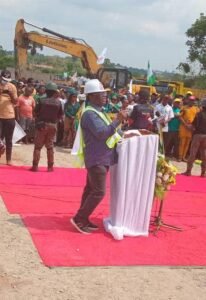
Ogbunike, Anambra State – March 25, 2025
Anambra State stood still as the much-anticipated Phase 2B construction of the access road to the Second Niger Bridge officially kicked off, signaling a new era of infrastructural transformation in the Southeast. The project, long awaited by commuters and businesses, has finally come to life under the watchful eyes of President Bola Ahmed Tinubu, who was represented by Governor Chukwuma Soludo and Minister of Works, Engr. Dave Umahi.
But the real showstopper of the day was the glowing tribute Umahi paid to Soludo, describing him as a “visionary leader” whose remarkable achievements continue to reshape Anambra. From aggressive road construction to a befitting Government House, improvements in security, healthcare, and education, Umahi declared that Soludo was setting new governance standards in Nigeria. He went further, calling the Anambra governor a loyal friend of President Tinubu, whose relationship with the President has attracted strategic federal projects to the state.

The event, held at Ogbunike (33 Nkwelle Junction) along the Enugu-Onitsha Expressway, was nothing short of historic. Traditional rulers, political leaders, and excited locals gathered to witness what many described as a major breakthrough for Southeast infrastructure. The Second Niger Bridge, inaugurated in 2023, had promised smoother connectivity for the region, but the absence of proper access roads had left its full potential unrealized—until now.
The Phase 2B construction will cover 17.5km of dual carriageway, seven bridges, and modern security infrastructure, stretching from the Umunya/Ogbunike axis to the Asaba-Igbuzor Road Interchange and Valley Bridge. Igwe Awkuzu, the closest traditional ruler to the venue, blessed the kola nut and prayed for a smooth and successful project.
Umahi, full of confidence, assured that President Tinubu is deeply committed to the Southeast’s infrastructural transformation. He revealed that 30 percent of the contract sum had already been paid and that disbursements would be strictly tied to the pace of work. He called on communities along the route to embrace the project and avoid disrupting construction activities, emphasizing that the road will open up massive economic opportunities.
Governor Soludo, in his trademark pragmatic style, wasted no time in driving home a hard truth: The Second Niger Bridge is incomplete until the full 35km access road is constructed. Acknowledging past delays, he expressed faith in Umahi’s leadership to see the project to completion. He called on traditional rulers, PGs, and youth leaders to ensure that work progresses without interruptions, stressing that collaboration, not disruption, will guarantee the project’s success.
Soludo further made a bold revelation—Anambra has already committed over N150 billion to federal roads. He insisted that dualizing key roads now is the only way to prevent a future of congestion and infrastructural decay, reinforcing his demand for federal-state synergy in road expansion projects.
The event also took a political twist as Hon. Chinwe Gwacgam, representing Oyi and Ayamelum Federal Constituency, made a bold call for Soludo’s re-election in 2025. According to him, sustaining Soludo’s leadership would ensure uninterrupted development, hinting at a strategic partnership between Anambra and the federal government beyond 2027.
Meanwhile, CGC Nigeria Limited, the contractor handling the project, reassured that the road would be delivered on schedule and in line with world-class standards.
With work now in full swing, the Southeast is on the verge of a transportation revolution. The access road to the Second Niger Bridge will not only ease traffic and enhance interstate commerce but also solidify Anambra’s place as an emerging economic hub. As shovels hit the ground, one message was clear—under Soludo’s leadership and Tinubu’s presidency, the future of Anambra’s infrastructure is brighter than ever.



